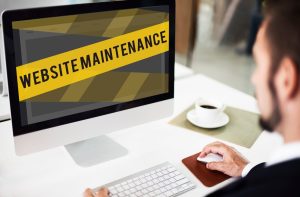Website maintenance is often overlooked, but it’s just as important as launching a website in the first place. A well-maintained website ensures smooth functionality, enhances user experience, and boosts your SEO efforts. In fact, a study by HubSpot found that 61% of consumers are more likely to purchase from a site that is mobile-friendly and regularly updated. This underscores the importance of staying on top of website maintenance. If you’re a business owner in the USA or the UK, creating a comprehensive website maintenance plan is a must, especially when outsourcing web development tasks. Today, we’ll walk you through the steps to create a website maintenance plan that keeps your site running smoothly while also addressing how outsourcing can play a role in your strategy.
What is a Website Maintenance Plan?
A website maintenance plan is essentially a structured schedule of activities to ensure your website remains up-to-date, secure, and fully functional. It involves regular checks and updates on various components such as content, security, performance, and SEO optimization. Without a maintenance plan, your site can become outdated or vulnerable to cyber threats. In fact, data from Website Planet suggests that over 30,000 websites are hacked every day, emphasizing the importance of regular maintenance. Whether you’re running an e-commerce store, a blog, or a corporate website, staying on top of maintenance tasks is crucial. But what exactly needs to be done? Let’s break it down.
Key Tasks to Include in Your Website Maintenance Plan
When creating a website maintenance plan, you want to cover several key areas. These tasks ensure your website remains functional, secure, and optimized for both users and search engines.
- Content Updates: Your website’s content should always be fresh and relevant. This means regularly updating blog posts, adding new product information, and refreshing outdated content. This helps maintain SEO ranking, as search engines love fresh content.
- Security Checks: A website is only as strong as its security measures. Regular updates to software, plugins, and themes are essential for keeping your website safe from cyber threats. An unsecured website risks data breaches and potential financial loss, so scheduling monthly security scans and updates is critical.
- Performance Optimization: Website speed affects both user experience and SEO. Regularly optimizing images, compressing files, and using a content delivery network (CDN) can drastically improve your site’s speed.
- SEO Optimization: SEO isn’t a one-time effort—it’s an ongoing task. Regularly reviewing your website’s SEO performance is important for staying competitive in search results.
- Backup and Recovery: Backing up your website is an often overlooked but essential task. In the event of a data loss, having regular backups will save you from starting from scratch.
- Mobile Responsiveness Checks: With mobile traffic surpassing desktop traffic in many markets, ensuring your website is mobile-friendly is vital. Regularly test your website across various devices to ensure it provides an excellent user experience on smartphones and tablets.
How Often Should You Perform Website Maintenance?
The frequency of website maintenance depends on the nature of your website. However, there are basic guidelines that you should follow:
- 1. Daily Tasks: Check for security vulnerabilities, respond to customer queries or issues, and monitor your website’s uptime and speed
- 2. Weekly Tasks: Make sure to backup your website, update content and product information, and test for broken links
- 3. Monthly Tasks: Endeavour to review SEO performance, update plugins and themes, and conduct a speed test and optimize images
- 4. Quarterly Tasks: Run a full security audit and review your website’s design and make adjustments if needed
Maintaining a consistent schedule ensures that important tasks aren’t overlooked, and your website remains in top shape.
Steps to Create a Website Maintenance Plan (Step-by-Step)
Now that we’ve covered the tasks to include, let’s dive into the steps to create a website maintenance plan.
Step 1: Define the Scope of Maintenance
The first step in the process is to determine what areas need to be maintained on your website. For instance, if you run an online store, regular product updates and payment system checks will be critical. On the other hand, if you have a blog, frequent content updates, SEO checks, and link audits should take priority.
Step 2: Set a Maintenance Schedule
Once you have defined the tasks, the next step is scheduling them. You should set up a clear calendar for each task based on its priority. For example, security updates should be scheduled monthly, while content updates might be done weekly. A clear, actionable schedule will keep you organized.
Step 3: Assign Responsibilities
Depending on your team, either assign these tasks internally or outsource them. For instance, if you lack in-house expertise, you may want to hire a WordPress developer or a designer to handle technical updates and design tweaks. If you need a reliable partner for ongoing support, companies like Bold Assistants offer skilled web developers and designers that can assist with your website maintenance needs.
Step 4: Track Performance and Update the Plan
Regularly reviewing your maintenance efforts will help you identify areas that need improvement. Are certain tasks taking too long? Are there areas you’re neglecting? Periodically assess your plan and make necessary adjustments.
Step 5: Set a Budget and Resources
Maintenance requires both time and money. It’s essential to budget for the software, tools, and outsourcing services you may need. For example, using tools like Google Analytics and WordPress management plugins can help automate some maintenance tasks.

How to Identify a Reliable Partner for Ongoing Website Maintenance
Outsourcing your website maintenance is a smart choice for businesses that don’t have an in-house team. But how do you choose a reliable partner? When evaluating outsourcing options, look for:
- Experience with WordPress and web design: Your partner should be well-versed in the latest web technologies and best practices for WordPress websites.
- Clear communication: A reliable partner should communicate effectively about deadlines, issues, and solutions.
- Scalability: Your partner should be able to handle future growth. Whether you’re adding new products or expanding your blog, your outsourcing partner should have the resources to scale.
- Security expertise: Your partner should prioritize security and provide regular updates to prevent cyber threats.
Bold Assistants specializes in connecting businesses with skilled WordPress developers and designers. Our team can help with the technical aspects of website maintenance, ensuring your site stays secure and optimized for performance.
Outsourcing Website Maintenance: Why It Makes Sense for Businesses
Outsourcing website maintenance comes with several benefits:
- Cost-effectiveness: Hiring an in-house team for ongoing website upkeep can be expensive, especially when it comes to hiring skilled developers or designers. Outsourcing, however, allows you to access top talent at a fraction of the cost.
- Access to expertise: By outsourcing to a specialized agency like Bold Assistants, you gain access to highly skilled professionals who can handle complex tasks such as security updates, performance optimization, and design improvements.
- Time savings: Outsourcing maintenance frees up your time, allowing you to focus on growing your business rather than dealing with the technical details of website upkeep.
Common Website Maintenance Mistakes to Avoid
While creating a maintenance plan is important, it’s equally crucial to avoid common mistakes that can undermine your efforts:
- Neglecting security updates: Hackers exploit outdated software. Always stay on top of security updates.
- Forgetting regular backups: Without backups, a data loss could result in significant downtime or loss of critical data.
- Ignoring mobile optimization: More users access websites from mobile devices than ever before. Ensure your site remains mobile-friendly to avoid losing traffic.
Tools and Resources to Help with Website Maintenance
There are several tools that can help automate and streamline your website maintenance tasks:
- UpdraftPlus: A popular plugin for backing up your WordPress site.
- Google Analytics: Monitor performance and track key metrics.
- WP Rocket: A caching plugin to speed up your website.
Conclusion: Establishing a Long-Term Website Maintenance Strategy
steps to create website maintenance plan is an ongoing commitment that requires attention to detail. Regular updates, security checks, and performance optimizations can improve user experience and keep your website competitive in the digital landscape. By outsourcing maintenance tasks to reliable professionals, you can focus on your business growth while ensuring your website remains secure and up-to-date.
Don’t wait until something breaks. Start building your website maintenance plan today—your business (and your website) will thank you for it. For professional WordPress development and design support, Bold Assistants is here to help.
FAQ
What is a website maintenance plan?
A website maintenance plan is a structured schedule of tasks to ensure your website remains secure, functional, and up-to-date. It includes activities like software updates, backups, and performance monitoring to keep your site running smoothly.
What tasks should be included in a website maintenance plan?
Essential tasks include regular updates to your CMS and plugins, backups, security scans, and performance optimization. Partnering with experts like Bold Assistants ensures these tasks are handled efficiently and affordably.
How often should website maintenance be performed?
Maintenance frequency depends on the task, with some like backups performed weekly and audits conducted monthly or quarterly. Consistency is key to avoiding technical issues and maintaining website performance.
Can I outsource my website maintenance tasks?
Yes, outsourcing is a cost-effective way to ensure professional and consistent website maintenance. Companies like Bold Assistants connect you with skilled WordPress developers who handle these tasks with expertise.
How do I choose the right website maintenance partner?
Choose a partner with proven experience, reliable tools, and positive client reviews. Agencies like Bold Assistants specialize in matching businesses with talented professionals to meet your specific needs.



